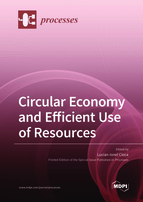Circular Economy and Efficient Use of Resources
A special issue of Processes (ISSN 2227-9717). This special issue belongs to the section "Sustainable Processes".
Deadline for manuscript submissions: closed (31 December 2021) | Viewed by 30397
Special Issue Editor
Interests: management; human resources management; occupational health and safety management; production systems engineering; ergonomics; circular economy
Special Issues, Collections and Topics in MDPI journals
Special Issue Information
Dear Colleagues,
Previous and current resource use models have led to high levels of pollution, environmental degradation, and depletion of natural resources. The waste policy has a long history and has traditionally focused on more environmentally sustainable waste management. To be efficient in terms of resource use, the principles of the circular economy should change this trend, transforming the economy into a sustainable economy. The new waste regulations introduce new waste management objectives in terms of waste prevention, reuse, recycling, and storage, by addressing new processes.
Prof. Dr. Lucian-Ionel Cioca
Guest Editor
Manuscript Submission Information
Manuscripts should be submitted online at www.mdpi.com by registering and logging in to this website. Once you are registered, click here to go to the submission form. Manuscripts can be submitted until the deadline. All submissions that pass pre-check are peer-reviewed. Accepted papers will be published continuously in the journal (as soon as accepted) and will be listed together on the special issue website. Research articles, review articles as well as short communications are invited. For planned papers, a title and short abstract (about 100 words) can be sent to the Editorial Office for announcement on this website.
Submitted manuscripts should not have been published previously, nor be under consideration for publication elsewhere (except conference proceedings papers). All manuscripts are thoroughly refereed through a single-blind peer-review process. A guide for authors and other relevant information for submission of manuscripts is available on the Instructions for Authors page. Processes is an international peer-reviewed open access monthly journal published by MDPI.
Please visit the Instructions for Authors page before submitting a manuscript. The Article Processing Charge (APC) for publication in this open access journal is 2400 CHF (Swiss Francs). Submitted papers should be well formatted and use good English. Authors may use MDPI's English editing service prior to publication or during author revisions.
Keywords
- circular economy
- ecological technologies
- ecological processes
- production processes
- resource efficiency
- production system and waste streams
- waste treatment and disposal
- plastics in the circular economy
- waste generation management and prevention
- ecological technologies
- medical waste
- sustainable process
- new trends in textiles






